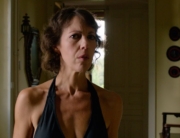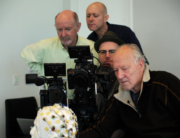Citizen Jane: Battle for the City opens with images of mammoth cities growing in China and India, accompanied by comments by local critics, all adding up to a drone’s eye view of why the work of Jane Jacobs still inspires urbanists globally to try and counter First World mistakes. Director Matt Tyrnauer is less fawning and more informative in this film than in his Valentino: The Last Emperor (2008) in profiling Jacobs as the activist and internationally renowned author of The Death and Life of Great American Cities (1961), which continues to influence the built environment, just as Rachel Carson’s Silent Spring (1962) does the natural one. (Her writings are voiced by Marisa Tomei.)
The film offers a preliminary quick history of city planning from the early 20th century, which sets up the titular battle between planners and Jacobs. Missing are images from the important Ralph Steiner/Willard Van Dyke/Pare Lorentz/Lewis Mumford short The City, which is now in the National Film Registry and presented bad old cities vs. preferred new, sterile, high-rise super-blocks (and which inspired me to become a city planner.)
During the golden age of New York’s master planner Robert Moses (voiced by Vincent D’Onofrio), he cut through neighborhoods in order to facilitate commuting to the suburbs. (The results can be seen to scale at my favorite exhibit at the Queens Museum, “Panorama of New York City,” originally commissioned by Moses.) But as Paul Goldberger and other architectural critics and urban designers explain, Moses and his ilk tore through the city’s fabric even more when they applied the same technique to a “war on slums,” justified by freighted language and class-based assumptions.
Jacobs was witness to these master plans as a journalist with Architectural Forum during the mid-1950s. She was the first to begin to challenge Philadelphia’s much-admired Edmund Bacon while touring his highly-touted redevelopments, asking “Where are the people?” The documentary shifts to Jacobs’ personal life with her move from small-town Pennsylvania to New York City, in order to be a writer, and then to Greenwich Village with her husband to raise their family. The most extensive and detailed section is the oral history of the fights she organized with other neighborhood mothers against Moses’s plans for highways through their blocks (including Washington Square Park).
She is shown to be the mother of all activists, using her writing skills by sending letters to editors, drafting position papers, flyers, and press releases about the noise. She also organized construction-blocking demonstrations and made rabble-rousing appearances at hearings at which she was arrested. The film interviews several of Jacobs’s friends, who gloat about their victories over the powers that be. Many went on to careers in city politics.
Her successful defense of Greenwich Village coalesced her thinking about the need for planners to look at cities from the level of the people at the street first, and to identify what is in fact economically and socially working—the most revolutionary challenge to planning orthodoxy since “Make no little plans” was attributed to Daniel Burnham in 1912. Her many TV appearances, which she made to promote her book and to speak about her work, made her Agnès Varda-like look, featuring a page boy haircut and big black glasses, iconic and photos of her can found in many archival gems.
Moses has been covered extensively in Robert Caro’s classic The Power Broker: Robert Moses and the Fall of New York (1975), on PBS’s American Experience, and in major museum exhibitions for his public sector investment in huge infrastructure projects. This film’s examination of Jacobs provides the other side of Moses’s more well-known story. One goal the producers have for the documentary is to guide and inspire viewers toward activism. However, the movie doesn’t much follow Jacobs’s involvement in Toronto, where she moved in 1968 to protect her sons from the U.S. military draft and wrote more broadly, and less convincingly, about The Economy of Cities (1969).
But through various examples in places ranging from London to India, enthusiastic acolytes of her urban design philosophy pay tribute to her impact and continuing relevance. Closer to her home, the “lively cities” movement, with mixed-use buildings, sidewalk cafes, farmers markets, pedestrian paths, and performance spaces, is a direct outgrowth of Jacobs’s book and commitment, making this a lively and relevant movie for today’s urban denizens.







Leave A Comment